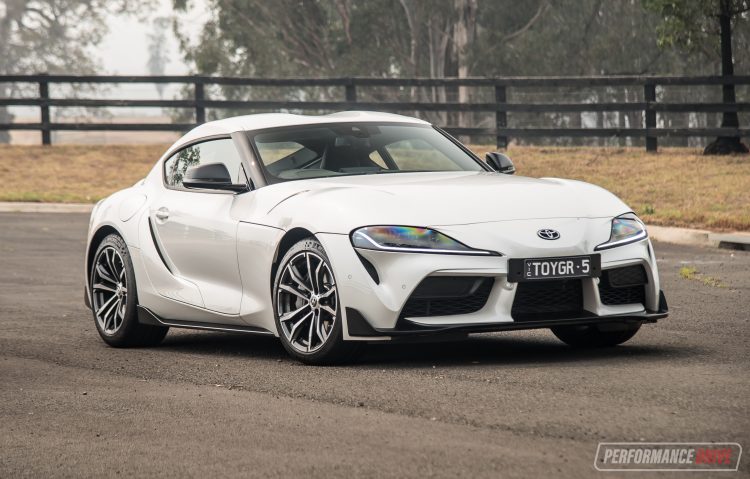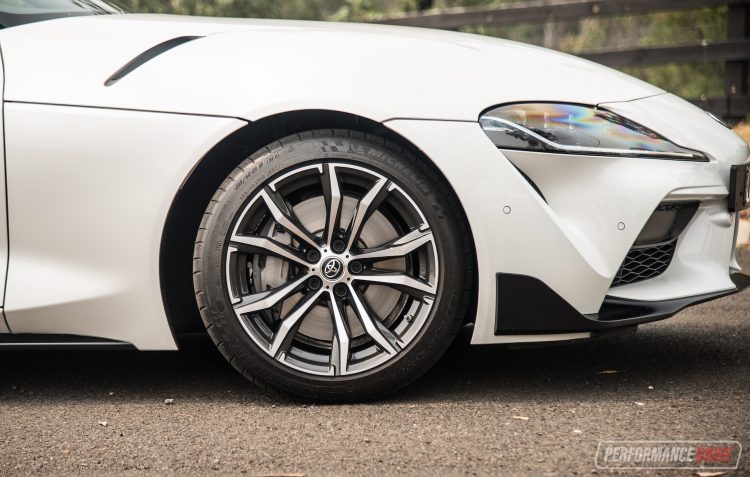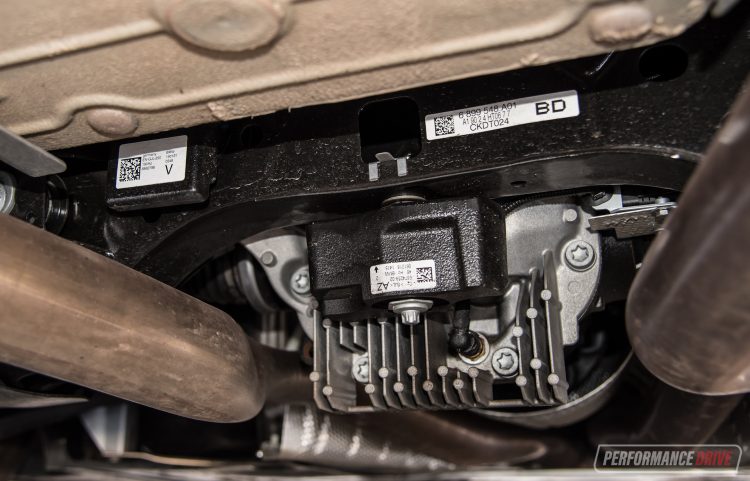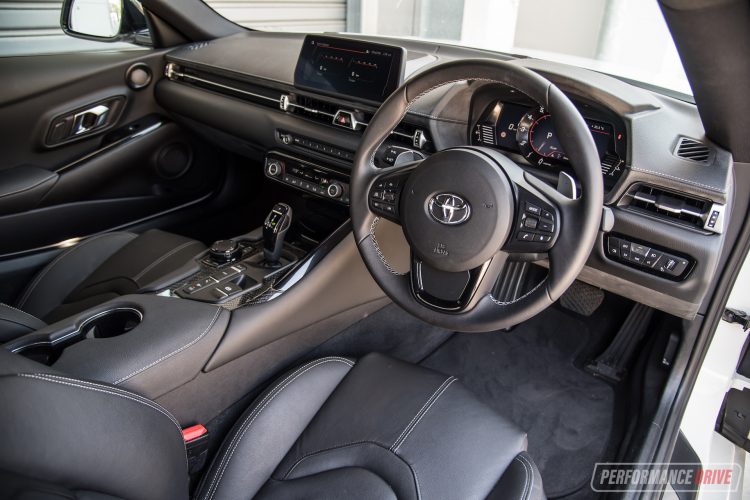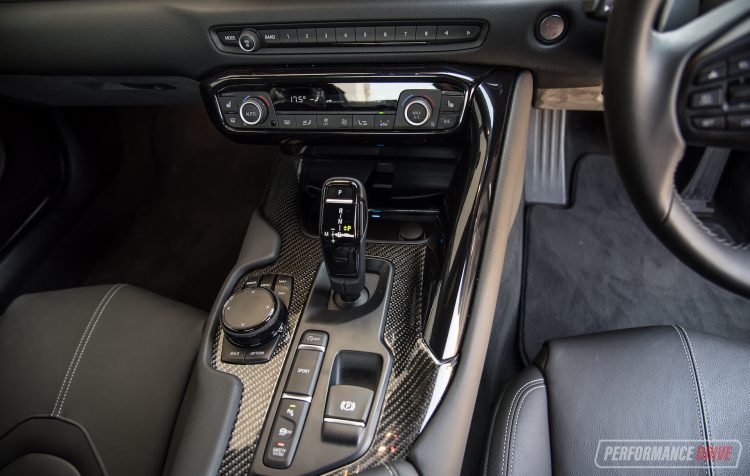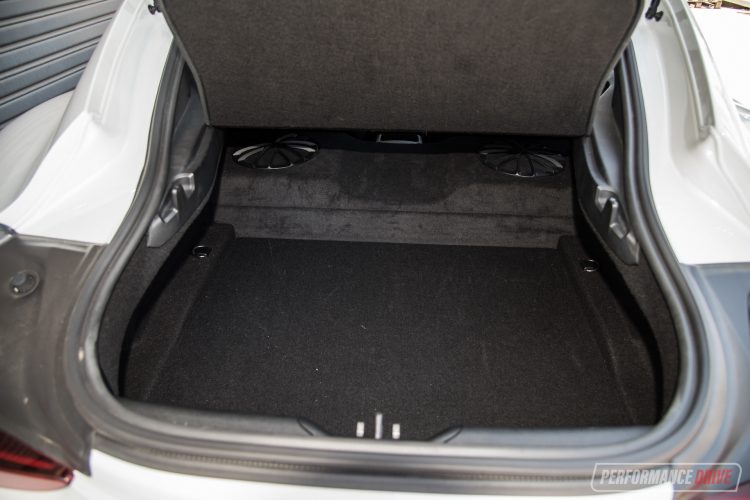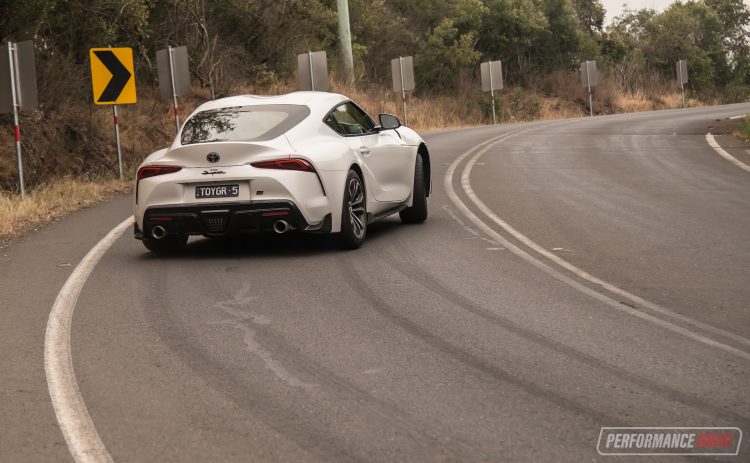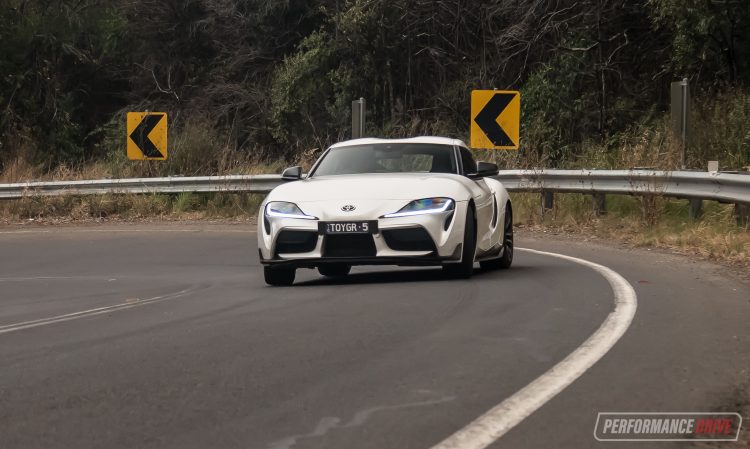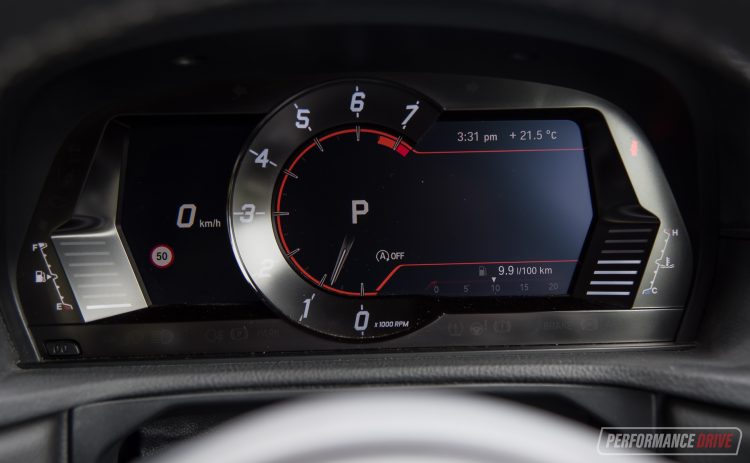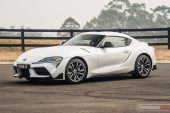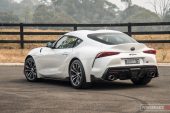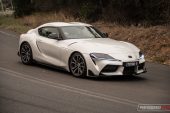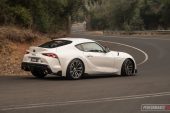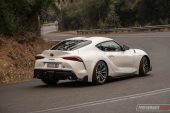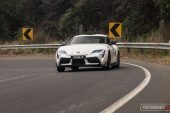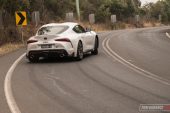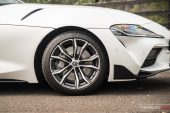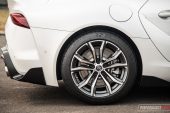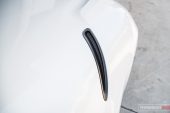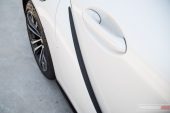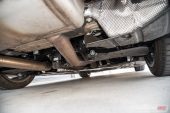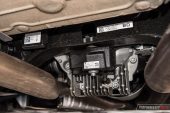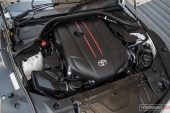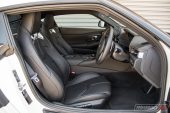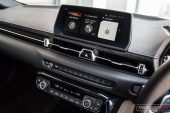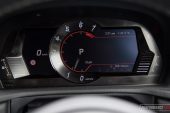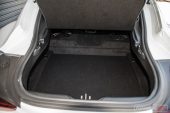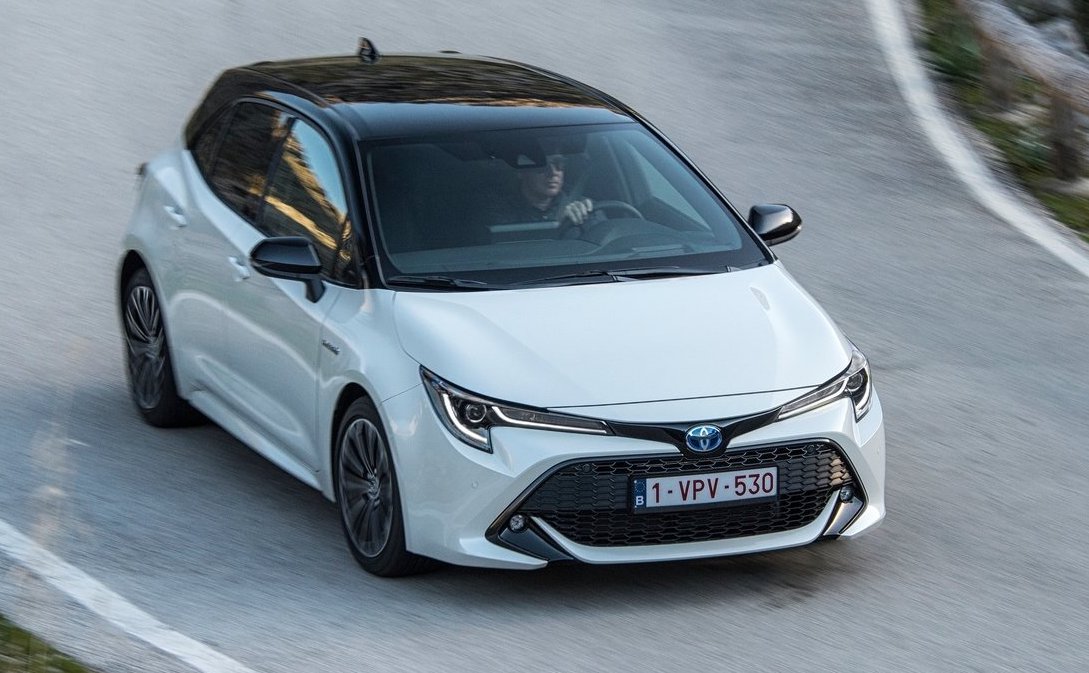While many carmakers, including Toyota, are busy working on new-age, super-eco powertrains and alternative transport solutions, the Toyota Supra nameplate has been dug out of the history books and is back for an all-new, modern interpretation. For passionate driving fans, this has to be one of the most exciting new car launches of the decade. It has four generations of pedigree behind it, with over 40 years experience in the top-end of the sports coupe segment. Needless to say, these are some big shoes to fill.
Shoes so big that in fact Toyota enlisted the help of BMW to develop the new model. Actually, it was a co-development partnership between the two, with BMW putting in its effort for the new Z4 and Toyota applying its needs for the Supra. But some have argued that there are more BMW parts in here than Toyota parts. Does that really matter? Is being semi-BMW such a bad thing?
Two variants are on sale in Australia; the GT and the GTS. Both come powered by BMW’s ‘B58’ 3.0-litre turbocharged inline six engine that produces 250kW and 500Nm, sent through a BMW/ZF eight-speed automatic transmission with rear-wheel drive. There is a 2.0-litre turbo four-cylinder option on the horizon, but it won’t be offered in Australia. If you really want a four-cylinder locally you’ll have to go to the Z4 sDrive20i or sDrive30i.
Pricing for the new GR Supra GT kicks off from $84,900, with the GTS starting from $94,900 (excluding on-road costs). Compared with the Z4 M40i (which now has 285kW), the GT is a whopping $30,000 cheaper. Still complaining about those BMW parts? Didn’t think so.
2020 Toyota GR Supra GT – THE SPECS
[column width=”47%” padding=”6%”]Engine: 3.0-litre turbo inline-six petrol
Output: 250kW@6500rpm / 500Nm@1600-4500rpm
Transmission: Eight-speed auto
Drive type: Rear-wheel drive, limited-slip diff
Wheels: F: 18×9.0, 255/40 R: 18×10, 275/40
ANCAP: Not tested
Tare weight: 1463kg
Power-to-weight: 5.85:1 (kg:kW)
Official fuel economy: 7.7L/100km
Economy during test: 8.6L/100km
Fuel capacity/Type: 52L/95 RON[/column] [column width=”47%” padding=”0″]Power efficiency: 32.47kW:L/100km
0-60km/h: 2.27 seconds*
0-100km/h: 4.38 seconds*
0-200km/h: 16.84 seconds*
60-110km/h: 2.86 seconds*
1/4 mile: 12.68 seconds at 181.1km/h*
Max acceleration: 0.864g
100-0km/h braking: 2.80 seconds at 35.83 metres*
Max deceleration: -1.218g
Decibel at idle: 56*
Peak decibel at 60-100km/h: 93*
Priced from: $84,900[/column][end_columns]
* Figures as tested by PerformanceDrive on the day. Factory claims may be different
2020 Toyota GR Supra GT – THE PACKAGE
Firstly, you might be wondering what’s with the ‘GR Supra’ name. Feel free to simply call it a Supra but Toyota has launched a new sub-division with its motorsport partner, Gazoo Racing. Going forward, the team will be helping out with the development of some new Toyota products. Soon you’ll be able to buy ‘GR Sport’ models, which are merely enhanced variants of exisiting Toyota vehicles, and you’ll be able to buy proper, bespoke performance models that will wear the ‘GR’ name, such as the GR Supra and the recent GR Yaris.
Further than that, there’s set to be really hardcore stuff on the way too, falling under the badge GRMN (Masters of Nurburgring); a Supra GRMN is apparently in the works, for example.
Let’s get back to this, though. Here we have the Supra GT entry model. It, like all variants, is based on BMW’s CLAR platform just like the Z4. It’s a stiff and lightweight layout constructed of high-strength steel and aluminium, leaving a perfectly balanced 50:50 weight distribution. Toyota says torsional rigidity actually exceeds that of the carbon fibre Lexus LFA V10 supercar. So that’s pretty awesome.
Even if you go for the base GT variant you still get all of the important performance driving stuff. Well, almost all. Both come with a Brembo brake setup using 348mm front ventilated discs clamped by four-piston calipers. However, on the GTS you get 345mm discs on the back compared with 330mm on the GT. The calipers are also painted red on the GTS, for all the trainspotters out there.
Aside from that though the GT comes with adaptive dampers with Normal and Sport modes, an electronic limited-slip differential, and staggered wheel and tyres sizes front and rear. To help set the GTS apart, visually, it comes with 19-inch wheels while the GT uses 18-inch alloys. These are wrapped in the excellent Michelin Pilot Super Sport tyres, measuring 255/40 on the front and 275/40 on the rear.
Inside, it is a pretty tight and focused two-seat driver’s car, so you probably shouldn’t expect much additional space. We’d definitely call it a sports car as opposed to a grand tourer, put it that way. Once you crouch down and snug yourself in, it’s all fairly serious. Visibility is quite good out the front thanks to the almost-vertical windscreen, and the view through the back isn’t too bad for a coupe. But, general freedom of movement is restricted due to the hunkered-in layout and low roof.
The sports seats are comfortable and they offer great lateral support for the back. Lateral support for the thighs isn’t as arresting, but with this portion of the seat being almost flat it means the seats can accommodate a wide range of differently shaped individuals. Toyota has applied reasonably high-quality materials in most areas as well, so it does feel premium and expensive. We wouldn’t say it is quite as premium as the Z4 M40i though, which comes with superior leather and other higher-class materials. But hey, this isn’t a comparison, and double-hey, the Z4 is $30,000 north of this.
One thing we do instantly notice from the excellent driver’s position is the centre console. It looks like it hasn’t been swapped from left-hand drive or something. There’s a big buttress section that shields the standard wireless phone charging cradle, and the BMW-based iDrive controller is located on the passenger side. This big chunk can make it feel more cramped and confined.
Up on the dash you’ll immediately recognise the BMW-like operating system for the 8.8-inch media screen. It’s not exactly the same as BMW’s latest 7.0 system, but it is extremely similar to the previous 6.0. Fortunately, Toyota has trimmed down some of the menus so it’s actually a bit easier to operate. We love the iDrive setup and the screen functionality in all BMWs, so it’s thumbs up from us.
The GT comes with sat-nav as standard, along with a rear-view camera, digital radio, and even a high-end 10-speaker sound system. In fact, the standard stereo is so vast it occupies a chunk of the boot space. The GR Supra offers 290L of cargo-carrying ability, with two aftermarket-style speakers mounted on the thick cross member between the rear wheels. At 290L though, it’s not too bad considering its nearest rival, the Nissan 370Z, offers only 235L. Netted storage pockets help to secure loose items and there’s a 12V socket in the back.
2020 Toyota GR Supra GT – THE DRIVE
The simplest way to describe the driving experience of the new Supra is to say it is perfect. It really is. Keeping in mind the Supra heritage which has long included an inline six engine. And keeping in mind its high-speed character and even its crowd-alluring presence. The GR Supra does all of this so wonderfully.
For starters, it’s a great thing that Toyota has turned to BMW for its engine as we think one of Toyota’s modern V6s just wouldn’t have done it justice. Straight sixes have a very distinct soundtrack, and for decades sports cars from Japan and Germany have adopted this layout. In the Supra you have a deep idle that soon turns into a melodic wail. It sings, and you can enjoy just listening to the engine without even thinking about the rest of the car.
Fortunately, this particular inline six not only offers a seductive soundtrack but also truly outstanding performance for its output. Toyota claims 0-100km/h comes up in 4.3 seconds. And to be honest, before we did any runs with our Vbox, we were a bit skeptical. To our surprise the car, in the real world, produced a best of 4.38 seconds. Right now it’s summertime in Australia. We did wait until the temperature dropped to around 24 degrees before testing, but in winter we’d predict a time of around 4.2 or even less.
You can really feel this performance from behind the wheel. The GT spec weighs 1463kg (tare) – not bad for a modern vehicle that comes with all of the latest mandatory safety systems – but with 500Nm of torque available from just 1600-4500rpm, the mid-range surge wrenches your gut and really pushes you back into your seat. With all of that torque available from low revs it means it is all-too-tempting to provoke wheelspin and enjoy some drifting action as well.
Even if you’re not much of a drifting fan, if you buy one of these we’d strongly recommend you take it to a track and give it a go. This is an awesome car to learn to drift in. Disengage the stability control, whack it into Sport mode and manual mode for the transmission, and get ready to smile for the rest of the day.
The steering system is very accurate and communicative, so you can just tip it into a corner, feed in the power, and gradually catch the slide as it happens with some opposite lock. From there you can either use the throttle to keep the slide going for as long as you like, sailing it right out there if you desire, or you can gradually back off to bow out. In either case, the Supra remains utterly composed and very friendly. There’s no tank-slap or any other negative or surprising kickback to contend with. It’s like it wants to do it, and we think it is obvious that Toyota/BMW engineers also want it to do it.
Even at higher speeds, initiating and during a slide, there’s a lot of control available. There’s grip beyond the traction threshold, in other words. That’s thanks to the Pilot Super Sport tyres no doubt, but also due the very rigid and responsive chassis. This is not one of those cars that snaps into oversteer.
Toyota’s suspension setting is slightly different to the Z4’s, but we think the Supra’s setup nudges ahead. Particularly for Australian conditions. There seems to be a bit more give and absorption, resulting in what feels like better control and less disturbance over mid-corner bumps. Sheer comfort is marginally ahead as well in our view.
When you’re done having fun at the track or up in the mountains, the GR Supra will happily be your everyday companion. Aside from a low nose, the suspension in Normal mode is forgiving enough (for a sports car), and all of the controls are conventional and fuss-free. The engine behaves really well, too. Again, thanks to that big torque available from low revs, you don’t need to look like a hoon just to escape from traffic at the lights. You can also surge your way in moving traffic and effortlessly overtake when needed.
On the official combined cycle the Supra chews 7.7L/100km, and we averaged around 8.6L/100km during our (mostly vigorous) testing. Strangely, the Z4 M40i is rated at 7.4L/100km under the same testing protocol. If anything it should be the other way around as the BMW is 40kg heavier, and we’re guessing a permanent metal roof would be more aerodynamic than a soft-top folding roof. We’ve done plenty of digging around to try and discover the reason for the difference in official consumption but nothing catches our eye.
The final drive ratio is 3.145:1 for both the Supra and Z4, and the exact same ZF-based 8HP51 eight-speed auto transmission is used in both, with the same ratios (1st: 5.250:1, 2nd: 3.360, 3rd: 2.172, 4th: 1.720, 5th: 1.316, 6th: 1.000, 7th: 0.822, 8th: 0.640). It doesn’t really matter as both figures are quite impressive considering the level of performance you get in return.
2020 Toyota GR Supra GT – THE VIDEOS
2020 Toyota GR Supra GT – THE VERDICT
Toyota says it wants to build more cars that are fun to drive. Forgetting that this features BMW parts – regardless of at what degree – this is a Toyota that you buy from a Toyota dealership. It comes with a five-year warranty and everything. Honestly, if we had to dream up the idea of a new Supra, which, admittedly, would be a very difficult task, it wouldn’t be as good as this. This is completely spot on, and proves, yes, Toyota is actively interested in offering cars that are fun to drive.
Before it debuted there were rumours that the new Supra would come with a hybrid engine, which may have detracted or even restricted its character, and some suggested it wouldn’t be quick enough and that it might even feature AWD. But it’s not any of those. Instead, it comes with one of the best six-cylinder engines on the new car market (in our opinion), it’s rear-wheel drive and handles like a dream, and despite showcasing fake body vents it looks stunning and attracts of lot of attention on the road. All of this spells pure Supra in our books.
[column width=”47%” padding=”6%”]PROS:
– Perfect engine character, sound and performance for Supra heritage
– Real driver’s car handling; very predictable, controllable drifting
– $30,000 cheaper than BMW Z4 M40i
– Distinctive Supra design
– Toyota 5-year/unlimited km warranty
[/column] [column width=”47%” padding=”0″]CONS:
– Centre console design seems like it’s from left-hand drive
– Not many storage options in the cabin
– Fake vents in the bodywork are disheartening[/column][end_columns]
As always, if you’re thinking about buying a new car don’t forget to click here to speak with our car buying specialists.
